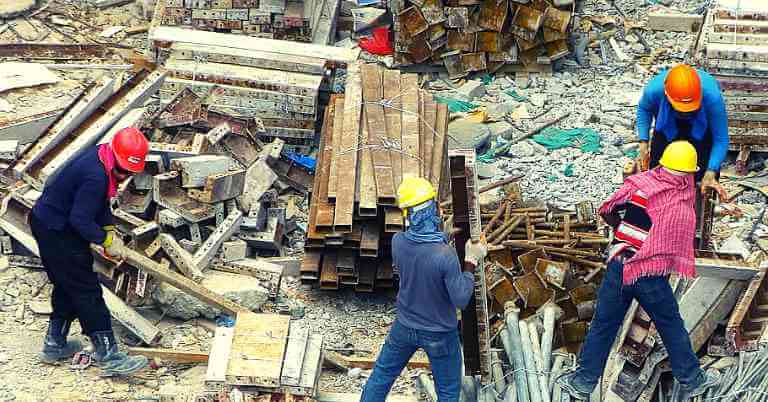In the ever-evolving landscape of construction and urban development, building site clearance is a crucial aspect that paves the way for progress. With the rapid advancements in technology and the growing emphasis on sustainable practices, the future of building site clearance holds promising innovations and trends that are set to reshape the industry. As we peer into the horizon of construction practices, it becomes evident that a wave of change is on the horizon. Let’s delve into the innovations and trends that will shape the future of building site clearance.
The Future of Building Site Clearance: Innovations and Trends to Watch
Automation Takes Center Stage
The days of manual labor dominating the site clearance process are gradually fading. Automation, fueled by robotics and artificial intelligence, is taking center stage. Drones equipped with advanced sensors are becoming indispensable tools for surveying and mapping large areas efficiently. These drones provide accurate data that aids in decision-making, reduces human risk, and expedites the clearance process.
In addition to drones, robotic machinery is being developed to handle various tasks in site clearance, such as demolishing structures and removing debris. These machines can navigate challenging terrains and perform repetitive tasks with precision, resulting in faster and more efficient clearance operations.
Sustainable Site Clearance Practices
Sustainability has become a cornerstone of modern construction practices. Eco-friendly site clearance methods, such as selective demolition and recycling, are gaining traction. The future will witness a shift towards reducing waste and conserving resources during site clearance, aligning with the broader goal of environmentally conscious construction.
Site managers are increasingly prioritizing salvaging reusable materials from demolished structures. This reduces the demand for new raw materials and minimizes the environmental impact of construction projects. Furthermore, the use of renewable energy sources to power machinery during site clearance contributes to a greener approach.
Data-Driven Decision Making
The integration of data analytics is revolutionizing site clearance processes. By leveraging data from previous projects and real-time monitoring, construction professionals can make informed decisions. Predictive analytics will enable proactive identification of potential challenges, leading to smoother clearance operations.
Advanced software solutions are being developed to analyze data collected during site surveys and clearance activities. These tools can identify patterns, optimize workflows, and provide insights to enhance efficiency. The ability to predict potential issues allows project managers to allocate resources effectively and mitigate delays.
Augmented Reality Enhancements
Augmented reality (AR) is poised to transform the way site clearance tasks are carried out. AR glasses and applications will provide on-site workers with overlays of essential information, such as utility locations, underground structures, and safety precautions. This technology enhances efficiency and reduces errors, contributing to a safer and more precise clearance process.
For instance, workers wearing AR glasses can visualize the locations of underground pipes and cables in real-time, minimizing the risk of accidentally damaging vital infrastructure. Additionally, AR can provide step-by-step instructions for tasks, reducing the need for extensive training and improving the accuracy of work.
Efficient Debris Management
Debris management is a critical aspect of site clearance. Innovations in waste segregation and disposal techniques will streamline the process. Automated sorting systems will categorize debris for recycling or proper disposal, optimizing the use of resources and reducing landfill waste.
Construction companies are investing in advanced sorting technologies that can identify different types of materials based on their composition and properties. This allows for efficient separation of materials like concrete, metal, wood, and plastics, making recycling more viable. Additionally, partnerships with recycling facilities are being established to ensure that materials are properly processed and reused.
Integration of BIM (Building Information Modeling)
BIM technology continues to play a pivotal role in construction projects. Its application in site clearance provides a virtual representation of the site, enabling stakeholders to visualize the process beforehand. This integration minimizes uncertainties and improves coordination among various teams involved in the clearance.
BIM models include detailed information about the existing structures, topography, and utilities on the site. This data aids in accurate planning and decision-making. Collaborative platforms allow architects, engineers, and construction managers to work together in a virtual environment, identifying potential clashes and optimizing the clearance plan before any physical work begins.
Robotics for Hazardous Environments
Some clearance tasks involve hazardous environments that pose risks to human workers. Robotic systems equipped with specialized tools will undertake these tasks, ensuring worker safety while maintaining efficiency. These robots will navigate challenging terrains and handle hazardous materials with precision.
Robotic systems are being designed to perform tasks such as removing hazardous materials like asbestos or handling contaminated soil. These machines can be remotely operated by skilled technicians, reducing the need for direct human involvement in dangerous environments. This approach not only safeguards workers’ health but also enhances the accuracy of hazardous material removal.
Collaborative Software Platforms
Communication and collaboration are paramount in site clearance projects. Advanced software platforms enable real-time information sharing among project teams, leading to better coordination, faster issue resolution, and improved overall project management.
Cloud-based collaboration tools allow multiple stakeholders to access project data, updates, and documents from anywhere, facilitating seamless communication. Project managers can assign tasks, track progress, and receive real-time updates, ensuring that all team members are on the same page and informed about project developments.
Eco-Friendly Equipment
The future will witness the rise of eco-friendly equipment powered by renewable energy sources. Electric machinery and solar-powered tools will replace traditional diesel-powered equipment, reducing emissions and minimizing the environmental impact of site clearance operations.
Electric excavators, bulldozers, and loaders are being developed to replace their diesel counterparts. These electric machines produce zero emissions on-site, resulting in improved air quality and reduced noise pollution. Furthermore, solar-powered equipment chargers are being introduced, utilizing renewable energy to recharge equipment batteries.
3D Printing for Clearing Obstacles
Innovations in 3D printing technology will revolutionize obstacle clearance. On-site 3D printers will fabricate temporary structures and tools required for efficient clearance, eliminating the need for transporting pre-fabricated components.
3D printers can create customized tools, supports, and barriers as needed for different clearance tasks. For example, if a specific support structure is required to prevent the collapse of adjacent buildings during demolition, it can be quickly designed and 3D-printed on-site. This approach reduces lead times and enhances adaptability.
Adaptive Clearance Strategies
Site conditions can vary widely, necessitating adaptive strategies. The future will see the development of adaptable clearance methods that cater to different terrains, weather conditions, and project scopes, ensuring optimal efficiency regardless of challenges.
Clearance plans will be designed with flexibility in mind, allowing adjustments based on unforeseen factors. For instance, if unexpected underground obstacles are encountered, the adaptive strategy might involve using specialized equipment or altering the demolition sequence to minimize disruptions.
Human-Machine Collaboration
While automation is on the rise, human expertise remains invaluable. The future of site clearance involves a seamless collaboration between humans and machines, combining the precision of technology with the problem-solving skills of human workers.
Skilled operators will work alongside automated machinery, ensuring that complex tasks are executed with the necessary attention to detail. Humans will also be responsible for supervising and fine-tuning the automated processes, ensuring that the desired outcomes are achieved safely and accurately.
Sensing Technologies for Site Analysis
Advanced sensing technologies, such as LiDAR and ground-penetrating radar, will enable comprehensive site analysis. These technologies provide accurate subsurface data, helping construction teams identify potential obstacles and underground structures before clearance begins.
LiDAR scanners can create detailed 3D maps of the site’s topography and existing structures. Ground-penetrating radar systems can detect buried utilities and foundations, allowing for accurate planning and risk assessment. Integrating these technologies into the site analysis process minimizes surprises during clearance and reduces the likelihood of costly errors.
Regulatory Compliance and Transparency
Stricter regulations and growing public awareness of environmental impacts underscore the need for regulatory compliance and transparency in site clearance. Future practices will prioritize adherence to regulations and proactive communication with local communities.
Companies will invest in compliance management systems that track and ensure adherence to relevant regulations. Additionally, transparent communication with nearby residents and stakeholders will become a standard practice, fostering community trust and minimizing potential conflicts.
Training and Skill Development
As technology evolves, training and skill development become essential. Training programs will equip workers with the necessary expertise to operate advanced machinery, interpret data analytics, and ensure the seamless implementation of innovative site clearance methods.
Construction companies will invest in training initiatives that focus on both technical skills and safety protocols. Workers will receive hands-on training with new equipment and technologies, enabling them to adapt to changing work environments and responsibilities effectively.
Predictive Maintenance of Equipment
Unplanned equipment downtime can significantly hamper clearance progress. Predictive maintenance powered by IoT devices will become commonplace, allowing for timely maintenance based on real-time data, minimizing disruptions.
Sensors installed on machinery will monitor factors such as temperature, vibration, and usage patterns. This data will be analyzed to predict when components are likely to fail. Preventive maintenance actions can then be scheduled before a breakdown occurs, ensuring that equipment operates at peak efficiency.
Remote Monitoring and Supervision
Remote monitoring solutions will enable project managers to oversee site clearance operations from a distance. Real-time video feeds, data dashboards, and communication tools will ensure efficient supervision and prompt decision-making.
Managers can use remote monitoring platforms to virtually tour the site, assess progress, and identify potential bottlenecks. This capability is especially valuable for large-scale projects or projects located in remote areas, where physical presence might not always be feasible.
Urban Site Clearance Challenges
Urban construction sites often present unique challenges due to limited space and high population density. Innovations will focus on optimizing clearance strategies to minimize disruptions, ensure safety, and maintain harmony with the urban environment.
Tackling urban clearance requires careful planning to prevent disturbances to nearby buildings and infrastructure. Customized equipment and techniques will be developed to work within tight spaces while minimizing noise and dust emissions. Public communication and coordination will play a vital role in managing urban clearance projects successfully.
The Role of Big Data
Big data analytics will revolutionize the construction industry, including site clearance. By analyzing vast amounts of data, construction professionals can identify trends, make accurate predictions, and continuously refine site clearance processes.
Data collected from various sources, such as equipment sensors, weather forecasts, and historical project data, will be harnessed to identify optimization opportunities. Machine learning algorithms will provide insights that aid in resource allocation, scheduling, and risk management, ultimately enhancing project outcomes.
Continuous Innovation and Adaptation
The future of building site clearance is characterized by continuous innovation and adaptation. As technology evolves and new challenges emerge, the industry will remain dynamic, embracing novel solutions and pushing the boundaries of what’s possible.
Companies that prioritize research and development will stay ahead of the curve, constantly seeking ways to improve efficiency, safety, and sustainability. Embracing a culture of innovation will ensure that site clearance processes evolve in tandem with the broader construction industry and societal needs.
“In the realm of site clearance, innovation paves the way for progress, and sustainability lays the foundation for a better future.”
Ultimate Rubbish Clearance: The Best Building Site Clearance Services Provider in London
When it comes to building site clearance services in London, there’s one name that stands out – Ultimate Rubbish Clearance. Choosing the right partner for your site clearance needs is crucial for a successful construction project, and here’s why we are the best choice:
Expertise and Experience
With years of experience in the industry, Ultimate Rubbish Clearance has honed its expertise in building site clearance. Our team of professionals understands the complexities involved in site clearance, from navigating legal regulations to efficiently managing debris and waste. Our track record speaks for itself, showcasing our ability to handle projects of varying scales and complexities.
Comprehensive Services
We offer a comprehensive range of building site clearance services, ensuring that every aspect of the clearance process is taken care of. From initial assessments and planning to executing the clearance with precision, our services cover every step of the way. Our goal is to provide a seamless and hassle-free experience for our clients, allowing them to focus on other critical aspects of their construction projects.
Advanced Technology
At Ultimate Rubbish Clearance, we stay at the forefront of technological advancements in the industry. We leverage state-of-the-art equipment and tools to ensure that our site clearance operations are efficient, safe, and environmentally friendly. Our investment in cutting-edge technology enables us to deliver exceptional results while adhering to the highest safety standards.
Sustainability Matters
We understand the importance of sustainable practices in today’s construction landscape. That’s why we prioritize eco-friendly methods in our site clearance processes. Our commitment to sustainability includes proper waste segregation, recycling, and responsible disposal practices. By choosing us, you’re not only getting superior clearance services but also contributing to a greener environment.
Customized Solutions
Every construction project is unique, and so are the site clearance requirements. At Ultimate Rubbish Clearance, we believe in delivering tailor-made solutions that align with our clients’ specific needs. Our team works closely with you to understand your project’s goals and challenges, ensuring that our site clearance strategy is customized to achieve the best outcomes.
Transparency and Reliability
Transparency is at the core of our business. We believe in maintaining open communication with our clients throughout the entire process. From cost estimates to project timelines, you can trust us to provide accurate and reliable information. Our commitment to transparency builds trust and ensures that there are no surprises along the way.
Customer-Centric Approach
Our clients are our top priority. We take pride in our customer-centric approach, which means that your satisfaction is paramount to us. Our team is dedicated to addressing your concerns, answering your questions, and accommodating any specific requests you may have. Your feedback matters, and we continuously strive to exceed your expectations.
Proven Results
Our past projects and satisfied clients are a testament to the quality of our building site clearance services. We have successfully cleared sites for a variety of construction projects, ranging from residential developments to commercial complexes. Our consistently positive feedback and referrals speak volumes about the level of service you can expect from us.
In the competitive landscape of building site clearance services in London, Ultimate Rubbish Clearance stands out as the top choice. Our combination of expertise, advanced technology, sustainability practices, and dedication to customer satisfaction sets us apart. When you choose us for your building site clearance needs, you’re choosing a partner that is committed to delivering excellence every step of the way.
Conclusion
The future of building site clearance is an exciting journey into a world where technology, sustainability, and efficiency converge. From automation and augmented reality to sustainable practices and predictive analytics, the innovations and trends discussed here will shape the landscape of site clearance for years to come. Embracing these advancements will not only enhance project efficiency but also contribute to a more sustainable and harmonious urban environment.






